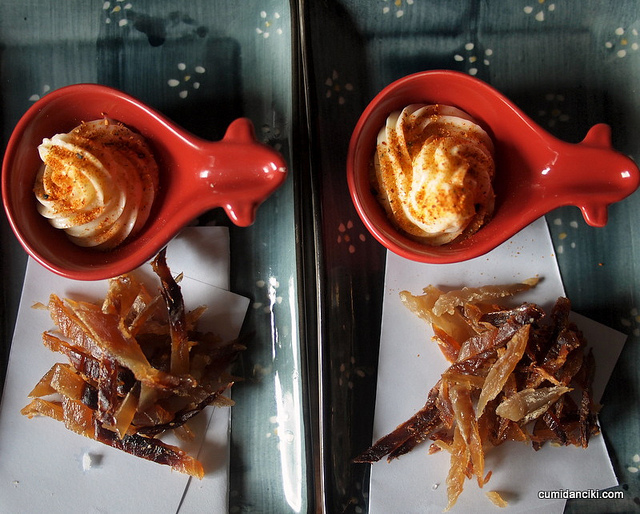 Photo by cumi&ciki
Photo by cumi&ciki
By Judith Clancy
Home of Japan’s Imperial Court from the 8th to the 19th century, the ancient city of Kyoto is famous for its excellent selection of fine traditional restaurants. Many of these specialize in kaiseki, a multi-course meal served on an exquisite array of tableware of distinctive shapes and colors. The more exclusive Kyoto restaurants (ryotei) can be quite expensive with prices averaging about $300 a person, sans alcohol, so a party of two or three can expect to spend about $1,000 for an evening meal. One reason for the high price is that each course reflects a seasonal and literary theme using carefully selected ingredients prepared and beautifully arranged in a time-honored manner. Although the nation is also the home of cup noodle (and a number of recognizable fast-food restaurants), most food in Japan, even café food, is freshly prepared to order. Nowadays, eating out is something of a national pastime in Japan, and food is one of most popular topics among Japanese, even surpassing their beloved sumo and baseball.
Notable among Kyoto’s many specialty dishes are tofu (soybean curd) and yuba, the skimmed paper-thin surface of boiled soybeans. These two items are often served in a kaiseki meal; their very delicate flavor is a centuries-old hallmark of the city’s food culture.
Kyoto is also famous for its architecture, be it massive Buddhist temples, Shinto shrines or machiya (merchant homes). A trend in the past ten years has seen many of these attractive wooden 100-year-old residences renovated and converted into restaurants. In the established, traditional ryotei restaurants, seating is generally on tatami mats, but the renovated townhouses provide sunken seating, where you sit on a tatami mat and comfortably rest your feet on a lower floorboard beneath the table. This welcome change has made traditional eateries very attractive to everyone, especially older customers.
 Photo by chacrebleu
Photo by chacrebleu
A new mini-lunchtime kaiseki meal has also been introduced, allowing you to sample typical Japanese fare without breaking the bank. Instead of getting the full eight courses offered in an evening kaiseki meal, you are served a mini-kaiseki, often in a lacquered box (or basket in summer) filled with delicacies and accompanied by a bowl of soup, plus rice and pickles.
Because preparation time for kaiseki is intensive, reservations are almost always needed, so having your hotel call the day before you go is wise, especially for smaller restaurants. Unless a customer has an allergy, people do not request certain foods but rely on the chef to present them with a beautiful and luscious array of dishes. (This is one reason so many Japanese diners whip out their camera and photograph the dish before them.)
For those eager to sample excellent Japanese cuisine, having lunch in one of these affordable yet elegant restaurants is a worthwhile introduction to Kyoto’s fine culinary arts.
 Photo by cumi&ciki
Photo by cumi&ciki
Juga offers a very reasonable lunch starting at ¥1,800, skillfully arranged on beautifully crafted tableware. Table and chair seating make the meal as comfortable to eat as it is affordable. West side of Ryogaemachi-dori, just south of Nijo-dori. Tel: 075-213-2234.
Kichijojo offers a ¥1,200 mini-kaiseki on luminous lacquerware. Table and chair seating is available on both floors. West side of Yanaginobanba-dori, just south of Rokkaku-dori. Tel: 075-241-7576.
Miko is a former lumber store converted into a restful kaiseki restaurant with table and chair seating in front and tatami rooms farther back. The lunchtime kaiseki set is ¥2,500 and is beautifully presented in a two-tiered box, plus dessert. 2 blocks south of Marutamachi-dori, just west of Kawaramachi-dori. Tel: 075-221-4826.
Ganko originally was the estate of lumber magnate Suminokura Ryoi (1554″“1614). The magnificent stroll garden with views from most rooms is alone worth a visit. The restaurant here is very popular. Sunken seating on tatami mats is available as is table and chair seating. Lunch starts at ¥3,000.The multiple-course meal contains sashimi (thin slices of fresh raw fish), vinaigrette, and grilled, boiled, and tempura selections with soup, rice and pickles at the end. East of Kiyamachi-dori, just south of Nijo-dori. Tel: 075-223-3456.
About the Author:
Judith Clancy is a long-time resident of Kyoto, where she has recently been named a Visit Kyoto Ambassador. This article is adapted from Kyoto Machiya Restaurant Guide: Affordable Dining in Traditional Townhouse Spaces (Stone Bridge Press, 2012), available in print and e-book formats.



